Abstract
Stimulation by isoproterenol causes large increases in the activity of rat pineal N-acetyltransferase (arylamine acetyltransferase or acetyl-CoA:arylamine N-acetyltransferase, EC 2.3.1.5) after a variable lag period. Lengthening periods of exposure to light cause rapid increases in the sensitivity of pineal N-acetyltransferase to induction by isoproterenol. This supersensitivity, which develops gradually over a 12 hr period, is correlated with increasingly longer lag periods in the induction of the enzyme, and with progressively greater maximal response. Repeated administration of isoproterenol to supersensitive animals rapidly reverses the above changes and causes relative subsensitivity. The sensitivity of N-acetyltransferase to induction by dibutyryl-cyclic tamp added to pineals in organ culture was found to change in parallel with the sensitivity to isoproterenol. Stimulation of cyclic AMP levels in the pineal by isoproterenol was also greater in supersensitive rats than in the subsensitive animals, whether the supersensitivity had been caused by denervation or by exposure to light for 12 hr. The above experiments suggest that there are two sites for the regulation of the sensitivity of N-acetyltransferase to induction by catecholamines. The first site regulates the capacity of intracellular processes (i.e., induction of tn-acetyltransferase) to respond to cyclic AMP as a second messenger.
Full text
PDF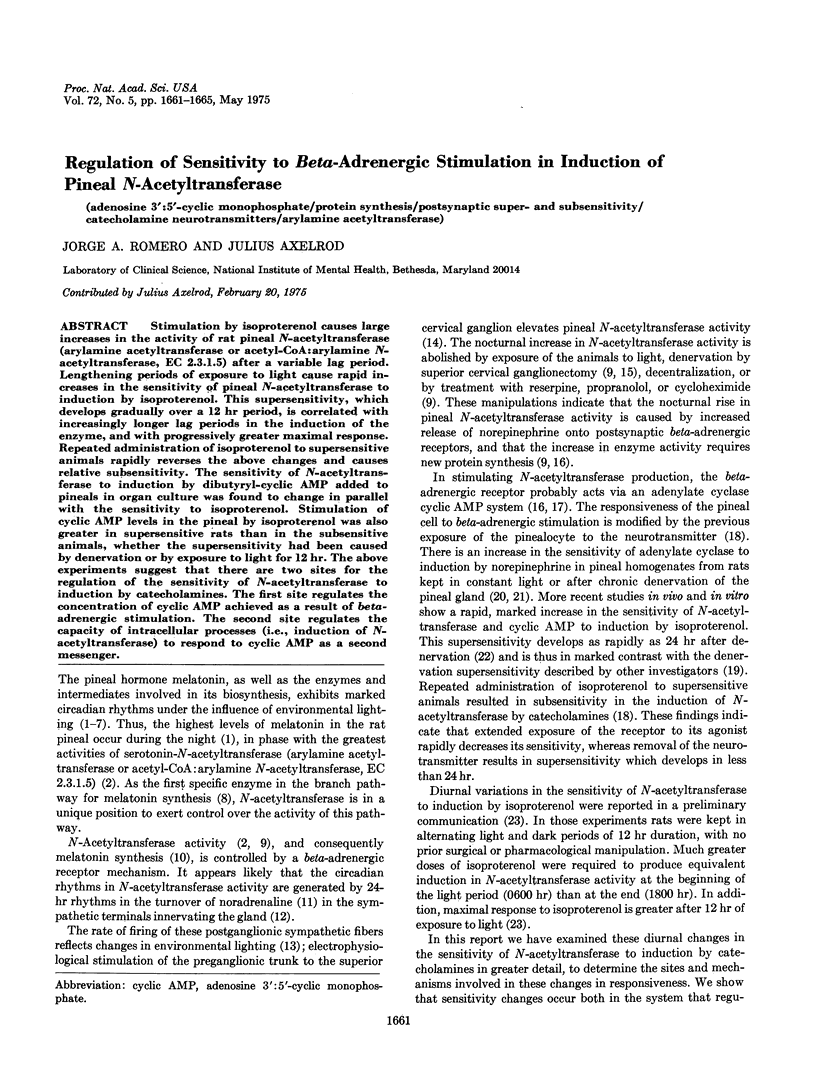
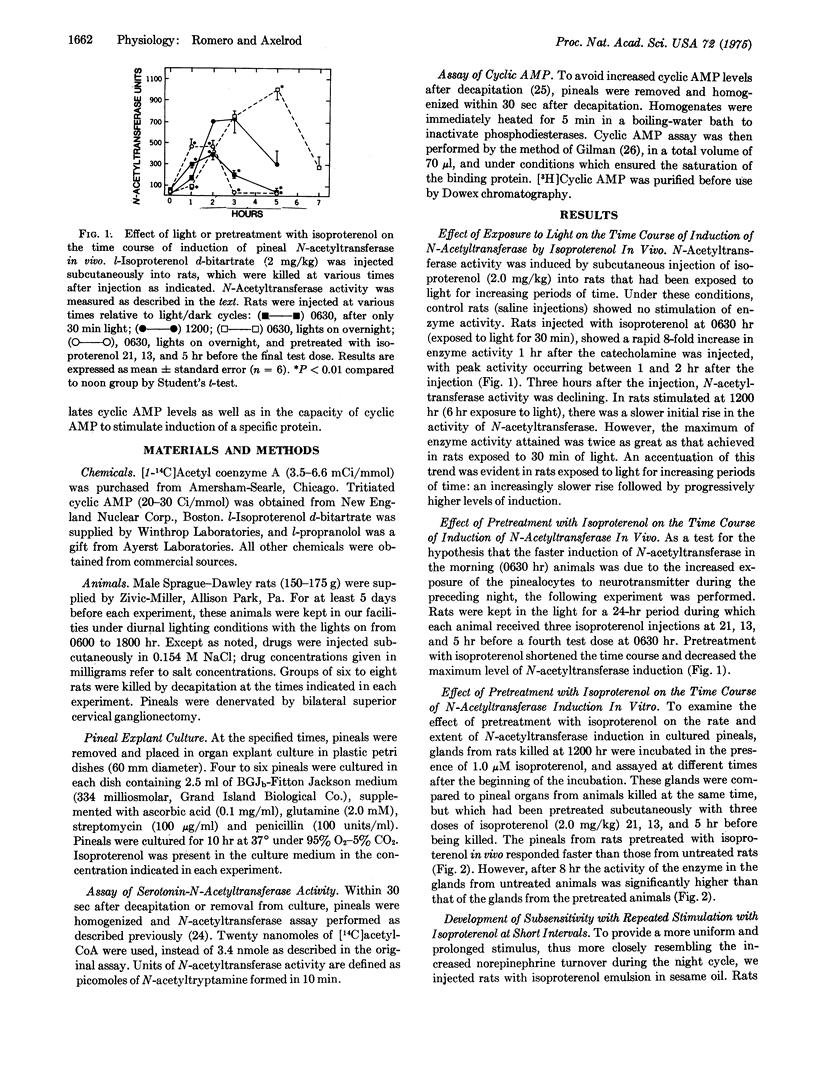
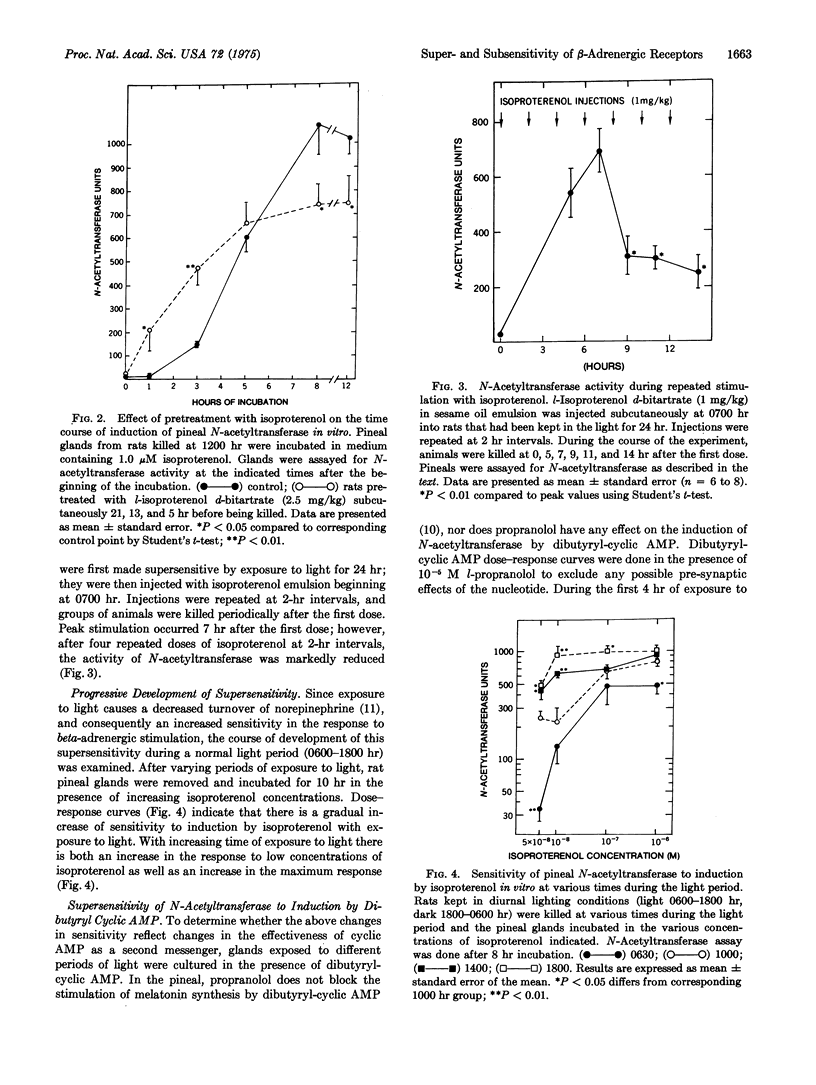
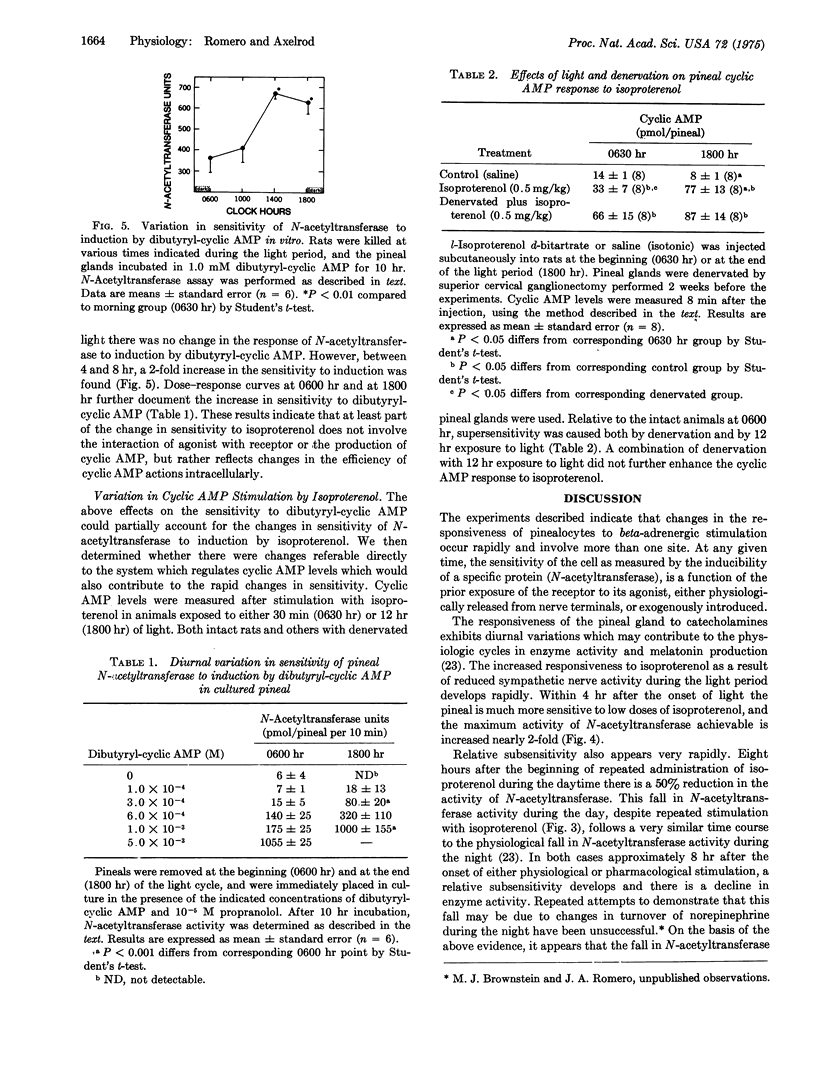
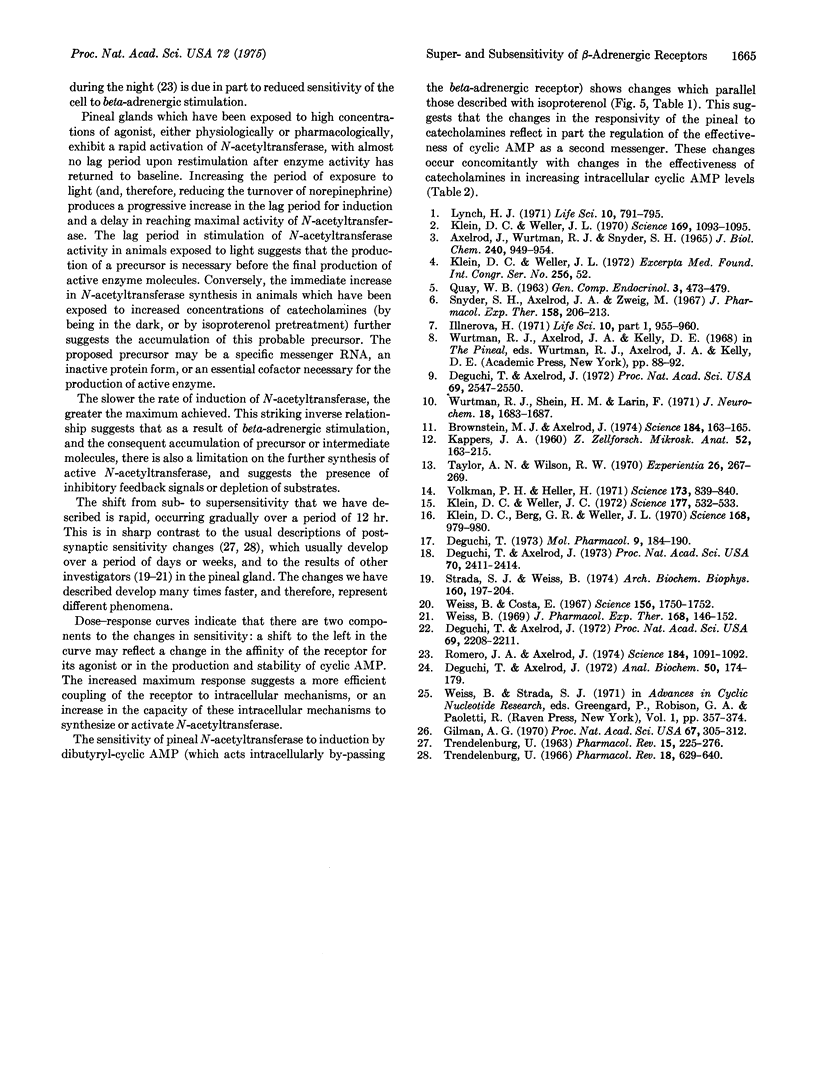
Selected References
These references are in PubMed. This may not be the complete list of references from this article.
- AXELROD J., WURTMAN R. J., SNYDER S. H. CONTROL OF HYDROXYINDOLE O-METHYLTRANSFERASE ACTIVITY IN THE RAT PINEAL GLAND BY ENVIRONMENTAL LIGHTING. J Biol Chem. 1965 Feb;240:949–954. [PubMed] [Google Scholar]
- Brownstein M., Axelrod J. Pineal gland: 24-hour rhythm in norepinephrine turnover. Science. 1974 Apr 12;184(4133):163–165. doi: 10.1126/science.184.4133.163. [DOI] [PubMed] [Google Scholar]
- Deguchi T., Axelrod J. Control of circadian change of serotonin N-acetyltransferase activity in the pineal organ by the beta--adrenergic receptor. Proc Natl Acad Sci U S A. 1972 Sep;69(9):2547–2550. doi: 10.1073/pnas.69.9.2547. [DOI] [PMC free article] [PubMed] [Google Scholar]
- Deguchi T., Axelrod J. Induction and superinduction of serotonin N-acetyltransferase by adrenergic drugs and denervation in rat pineal organ. Proc Natl Acad Sci U S A. 1972 Aug;69(8):2208–2211. doi: 10.1073/pnas.69.8.2208. [DOI] [PMC free article] [PubMed] [Google Scholar]
- Deguchi T., Axelrod J. Sensitive assay for serotonin N-acetyltransferase activity in rat pineal. Anal Biochem. 1972 Nov;50(1):174–179. doi: 10.1016/0003-2697(72)90496-4. [DOI] [PubMed] [Google Scholar]
- Deguchi T., Axelrod J. Supersensitivity and subsensitivity of the beta-adrenergic receptor in pineal gland regulated by catecholamine transmitter. Proc Natl Acad Sci U S A. 1973 Aug;70(8):2411–2414. doi: 10.1073/pnas.70.8.2411. [DOI] [PMC free article] [PubMed] [Google Scholar]
- Deguchi T. Role of the beta adrenergic receptor in the elevation of adenosine cyclic 3',5'-monophosphate and induction of serotonin N-acetyltransferase in rat pineal glands. Mol Pharmacol. 1973 Mar;9(2):184–190. [PubMed] [Google Scholar]
- Gilman A. G. A protein binding assay for adenosine 3':5'-cyclic monophosphate. Proc Natl Acad Sci U S A. 1970 Sep;67(1):305–312. doi: 10.1073/pnas.67.1.305. [DOI] [PMC free article] [PubMed] [Google Scholar]
- Illnerová H. Effect of light on the serotonin content of the pineal gland. Life Sci I. 1971 Aug 15;10(16):955–960. doi: 10.1016/0024-3205(71)90360-2. [DOI] [PubMed] [Google Scholar]
- KAPPERS J. A. The development, topographical relations and innervation of the epiphysis cerebri in the albino rat. Z Zellforsch Mikrosk Anat. 1960;52:163–215. doi: 10.1007/BF00338980. [DOI] [PubMed] [Google Scholar]
- Klein D. C., Berg G. R., Weller J. Melatonin synthesis: adenosine 3',5'-monophosphate and norepinephrine stimulate N-acetyltransferase. Science. 1970 May 22;168(3934):979–980. doi: 10.1126/science.168.3934.979. [DOI] [PubMed] [Google Scholar]
- Klein D. C., Weller J. L. Indole metabolism in the pineal gland: a circadian rhythm in N-acetyltransferase. Science. 1970 Sep 11;169(3950):1093–1095. doi: 10.1126/science.169.3950.1093. [DOI] [PubMed] [Google Scholar]
- Klein D. C., Weller J. L. Rapid light-induced decrease in pineal serotonin N-acetyltransferase activity. Science. 1972 Aug 11;177(4048):532–533. doi: 10.1126/science.177.4048.532. [DOI] [PubMed] [Google Scholar]
- Lynch H. J. Diurnal oscillations in pineal melatonin content. Life Sci I. 1971 Jul 15;10(14):791–795. doi: 10.1016/0024-3205(71)90033-6. [DOI] [PubMed] [Google Scholar]
- QUAY W. B. CIRCADIAN RHYTHM IN RAT PINEAL SEROTONIN AND ITS MODIFICATIONS BY ESTROUS CYCLE AND PHOTOPERIOD. Gen Comp Endocrinol. 1963 Oct;3:473–479. doi: 10.1016/0016-6480(63)90079-0. [DOI] [PubMed] [Google Scholar]
- Romero J. A., Axelrod J. Pineal beta-adrenergic receptor: diurnal variation in sensitivity. Science. 1974 Jun 7;184(4141):1091–1092. doi: 10.1126/science.184.4141.1091. [DOI] [PubMed] [Google Scholar]
- Snyder S. H., Axelrod J., Zweig M. Circadian rhythm in the serotonin content of the rat pineal gland: regulating factors. J Pharmacol Exp Ther. 1967 Nov;158(2):206–213. [PubMed] [Google Scholar]
- Strada S. J., Weiss B. Increased response to catecholamines of the cyclic AMP system of rat pineal gland induced by decreased sympathetic activity. Arch Biochem Biophys. 1974 Jan;160(1):197–204. doi: 10.1016/s0003-9861(74)80026-3. [DOI] [PubMed] [Google Scholar]
- TRENDELENBURG U. Supersensitivity and subsensitivity to sympathomimetic amines. Pharmacol Rev. 1963 Jun;15:225–276. [PubMed] [Google Scholar]
- Taylor A. N., Wilson R. W. Electrophysiological evidence for the action of light on the pineal gland in the rat. Experientia. 1970 Mar 15;26(3):267–269. doi: 10.1007/BF01900087. [DOI] [PubMed] [Google Scholar]
- Trendelenburg U. Mechanisms of supersensitivity and subsensitivity to sympathomimetic amines. Pharmacol Rev. 1966 Mar;18(1):629–640. [PubMed] [Google Scholar]
- Volkman P. H., Heller A. Pineal N-acetyltransferase activity: effect of sympathetic stimulation. Science. 1971 Aug 27;173(3999):839–840. doi: 10.1126/science.173.3999.839. [DOI] [PubMed] [Google Scholar]
- Weiss B., Costa E. Adenyl cyclase activity in rat pineal gland: effects of chronic denervation and norepinephrine. Science. 1967 Jun 30;156(3783):1750–1752. doi: 10.1126/science.156.3783.1750. [DOI] [PubMed] [Google Scholar]
- Weiss B. Effects of environmental lighting and chronic denervation on the activation of adenyl cyclase of rat pineal gland by norepinephrine and sodium fluoride. J Pharmacol Exp Ther. 1969 Jul;168(1):146–152. [PubMed] [Google Scholar]
- Wurtman R. J., Shein H. M., Larin F. Mediation by -adrenergic receptors of effect of norepinephrine on pineal synthesis of ( 14 C)serotonin and ( 14 C)melatonin. J Neurochem. 1971 Sep;18(9):1683–1687. doi: 10.1111/j.1471-4159.1971.tb03741.x. [DOI] [PubMed] [Google Scholar]


